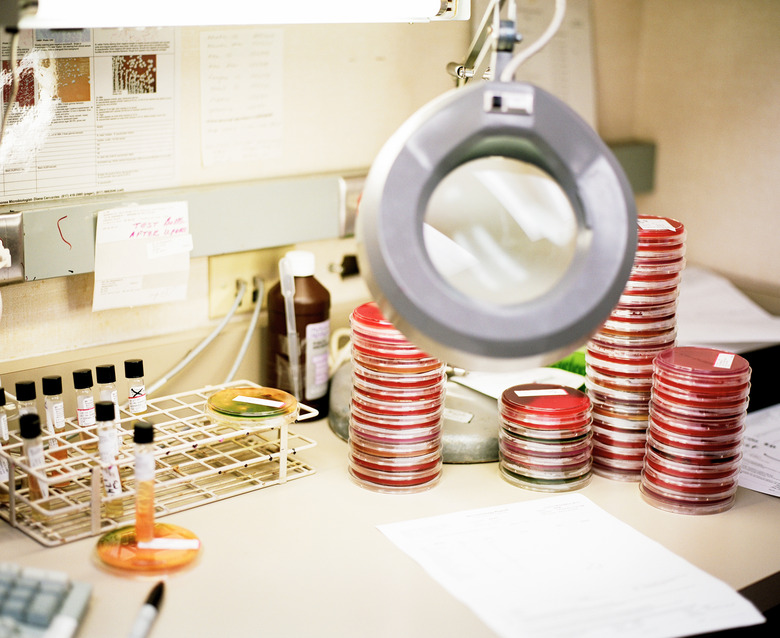Crowded Plate Techniques In Microbiology
Many of the most useful antibiotics are derived from compounds originally isolated from microorganisms. Penicillin, as is well known, was first discovered in mold, and various other antibiotics were isolated from soil bacteria in the 1950s and 1960s. One way to find microorganisms that may be producing antibiotic compounds is the "crowded plate technique." Although useful, this method also suffers from several important limitations.
Plates
Plates
First, a sample of organisms from soil or some other source is diluted in water, then spread onto Petri dishes containing agar gel rich in the nutrients the bacteria will need to grow. Scientists select plates that have a large number of colonies, then look for microorganisms that have inhibited the growth of other microorganisms in their vicinity. These microbes are possibly secreting some kind of compound that is killing or inhibiting their neighbors.
Purification
Purification
Colonies that may be producing antibiotics are transferred to another plate so they can be purified and grown in isolation. It's entirely possible, of course, that the colony was really just altering the pH of its environment or making some other change that killed other bacteria, rather than secreting an antibiotic, so further tests are needed to confirm that it is indeed an antibiotic-producing strain. Nonetheless, the crowded plate technique was sometimes helpful in identifying microorganisms that could serve as sources of new antibiotics.
Advantages
Advantages
The crowded plate technique is fairly simple — indeed, the simplest method to find antibiotic-producing microorganisms in soil samples. It's also fairly rapid, taking only a couple of days to produce results. Introducing "test organisms" can help to determine whether a specific kind of microorganism (e.g., a disease-causing germ) is susceptible to the antibiotic compound. If it does indeed prove useful for this purpose, the compound can be isolated for further study.
Drawbacks
Drawbacks
The crowded plate technique only detects microorganisms that produce compounds to kill bacteria found in their immediate environment. These compounds could potentially be toxic to humans, and they may be lethal only to certain types of bacteria (e.g., soil bacteria), as opposed to the bacteria that actually cause disease in humans. Moreover, they will only detect microorganisms that start to produce antibiotic compounds within a couple of days of being cultured and incubated, so they might well miss other compounds that could potentially be of interest.
References
- Pharmaceutical Biotechnology; Chandrakant R. Kokare; 2007
- Tropical Journal of Pharmaceutical Research; Isolation and Morphological Characterization of...; Basavaraj Nanjwade, et al.; 2010
- American Society for Microbiology; A Method for Investigating Large Microbial Populations...; Albert Kelner; 1948
Cite This Article
MLA
Brennan, John. "Crowded Plate Techniques In Microbiology" sciencing.com, https://www.sciencing.com/crowded-plate-techniques-microbiology-8773139/. 24 April 2017.
APA
Brennan, John. (2017, April 24). Crowded Plate Techniques In Microbiology. sciencing.com. Retrieved from https://www.sciencing.com/crowded-plate-techniques-microbiology-8773139/
Chicago
Brennan, John. Crowded Plate Techniques In Microbiology last modified August 30, 2022. https://www.sciencing.com/crowded-plate-techniques-microbiology-8773139/
